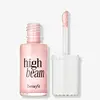What's inside
What's inside
 Key Ingredients
Key Ingredients

 Benefits
Benefits

 Concerns
Concerns

 Ingredients Side-by-side
Ingredients Side-by-side

Talc
AbrasiveDimethicone
EmollientIsododecane
EmollientCaprylic/Capric Triglyceride
MaskingSynthetic Fluorphlogopite
Mica
Cosmetic ColorantPhenoxyethanol
PreservativeCI 77163
Cosmetic ColorantCI 77891
Cosmetic ColorantIron Oxides
CI 75470
Cosmetic ColorantCI 19140
Cosmetic ColorantCI 77742
Cosmetic ColorantBis-Dimethicone
EmollientDiisostearyl Malate
EmollientPolyethylene
AbrasiveCetyl Dimethicone
EmollientTin Oxide
AbrasiveAluminum Calcium Sodium Silicate
Calcium Sodium Borosilicate
Calcium Aluminum Borosilicate
Silica
AbrasiveTalc, Dimethicone, Isododecane, Caprylic/Capric Triglyceride, Synthetic Fluorphlogopite, Mica, Phenoxyethanol, CI 77163, CI 77891, Iron Oxides, CI 75470, CI 19140, CI 77742, Bis-Dimethicone, Diisostearyl Malate, Polyethylene, Cetyl Dimethicone, Tin Oxide, Aluminum Calcium Sodium Silicate, Calcium Sodium Borosilicate, Calcium Aluminum Borosilicate, Silica
Water
Skin ConditioningCaprylic/Capric/Succinic Triglyceride
EmollientMica
Cosmetic ColorantPentylene Glycol
Skin ConditioningPolymethyl Methacrylate
Dimethicone
EmollientLimnanthes Alba Seed Oil
Skin ConditioningDimethicone PEG-7 Phosphate
CleansingTrimethylsiloxysilicate
EmollientHydroxyethyl Acrylate/Sodium Acryloyldimethyl Taurate Copolymer
Emulsion StabilisingPhenoxyethanol
PreservativeSteareth-21
CleansingSqualane
EmollientCaprylyl Glycol
EmollientSteareth-2
EmulsifyingTocopheryl Acetate
AntioxidantPolysorbate 60
EmulsifyingSodium Stearoyl Glutamate
CleansingButylene Glycol
HumectantSorbitan Isostearate
EmulsifyingSodium Hydroxide
BufferingCI 12085
Cosmetic ColorantCI 15850
Cosmetic ColorantCI 15985
Cosmetic ColorantCI 19140
Cosmetic ColorantCI 42090
Cosmetic ColorantCI 45380
Cosmetic ColorantCI 45410
Cosmetic ColorantCI 73360
Cosmetic ColorantCI 77891
Cosmetic ColorantCI 77163
Cosmetic ColorantCI 77491
Cosmetic ColorantCI 77492
Cosmetic ColorantCI 77499
Cosmetic ColorantCI 77742
Cosmetic ColorantWater, Caprylic/Capric/Succinic Triglyceride, Mica, Pentylene Glycol, Polymethyl Methacrylate, Dimethicone, Limnanthes Alba Seed Oil, Dimethicone PEG-7 Phosphate, Trimethylsiloxysilicate, Hydroxyethyl Acrylate/Sodium Acryloyldimethyl Taurate Copolymer, Phenoxyethanol, Steareth-21, Squalane, Caprylyl Glycol, Steareth-2, Tocopheryl Acetate, Polysorbate 60, Sodium Stearoyl Glutamate, Butylene Glycol, Sorbitan Isostearate, Sodium Hydroxide, CI 12085, CI 15850, CI 15985, CI 19140, CI 42090, CI 45380, CI 45410, CI 73360, CI 77891, CI 77163, CI 77491, CI 77492, CI 77499, CI 77742
 Reviews
Reviews

Ingredients Explained
These ingredients are found in both products.
Ingredients higher up in an ingredient list are typically present in a larger amount.
CI 19140 is also known as Tartrazine. Tartrazine is a synthetic dye used in cosmetics, foods, and medicine to add a yellow color.
Tartrazine is created from petroleum and is water-soluble.
Some people may experience allergies from this dye, especially asthmatics and those with an aspirin intolerance.
Learn more about CI 19140This synthetic powder is used to add a pearly/white color in cosmetics.
This ingredient is used to add a violet color to cosmetics.
It is created by reacting phosphoric acid, ammonium dihydrogen orthophosphate, and manganese dioxide.
Ci 77891 is a white pigment from Titanium dioxide. It is naturally found in minerals such as rutile and ilmenite.
It's main function is to add a white color to cosmetics. It can also be mixed with other colors to create different shades.
Ci 77891 is commonly found in sunscreens due to its ability to block UV rays.
Learn more about CI 77891Dimethicone is a type of synthetic silicone created from natural materials such as quartz.
What it does:
Dimethicone comes in different viscosities:
Depending on the viscosity, dimethicone has different properties.
Ingredients lists don't always show which type is used, so we recommend reaching out to the brand if you have questions about the viscosity.
This ingredient is unlikely to cause irritation because it does not get absorbed into skin. However, people with silicone allergies should be careful about using this ingredient.
Note: Dimethicone may contribute to pilling. This is because it is not oil or water soluble, so pilling may occur when layered with products. When mixed with heavy oils in a formula, the outcome is also quite greasy.
Learn more about DimethiconeMica is a naturally occurring mineral used to add shimmer and color in cosmetics. It can also help improve the texture of a product or give it an opaque, white/silver color.
Serecite is the name for very fine but ragged grains of mica.
This ingredient is often coated with metal oxides like titanium dioxide. Trace amounts of heavy metals may be found in mica, but these metals are not harmful in our personal products.
Mica has been used since prehistoric times throughout the world. Ancient Egyptian, Indian, Greek, Roman, Aztec, and Chinese civilizations have used mica.
Learn more about MicaPhenoxyethanol is a preservative that has germicide, antimicrobial, and aromatic properties. Studies show that phenoxyethanol can prevent microbial growth. By itself, it has a scent that is similar to that of a rose.
It's often used in formulations along with Caprylyl Glycol to preserve the shelf life of products.